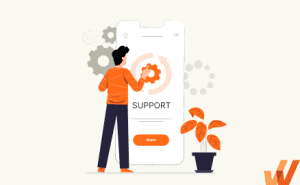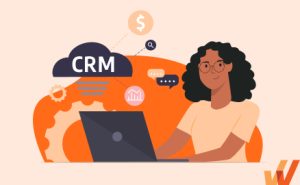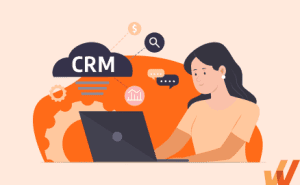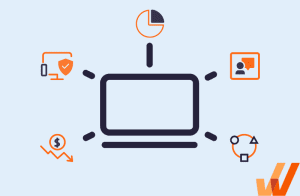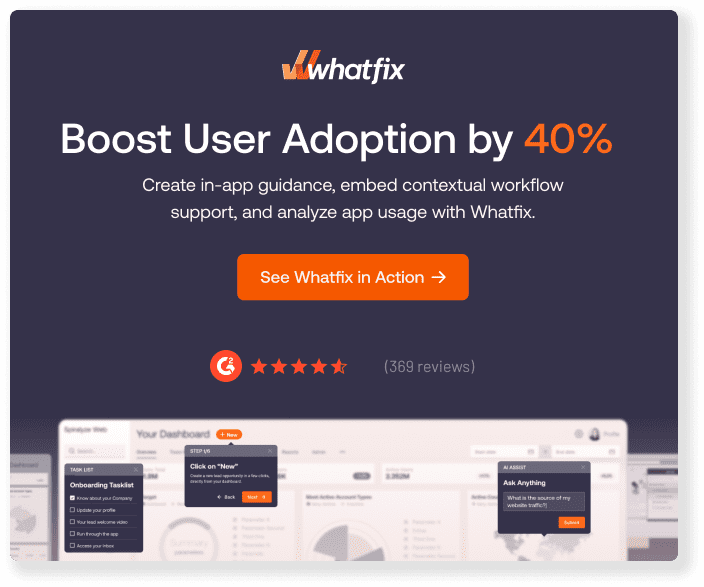Enterprise CRM platforms are the backbone of every large sales organization. From managing deal pipelines and automating sales workflows to orchestrating multi-touch customer engagements, CRMs enable revenue teams to operate at scale.
But as the pace of innovation accelerates, and buyers demand more personalized, responsive experiences, legacy CRM systems are falling short. They’re often rigid, lack intelligent automation, and require manual data entry, slows reps down and limits leadership visibility into what drives revenue.
Today’s next-gen CRMs promise much more than digital Rolodexes. They offer AI-powered forecasting, seamless integrations across your tech stack, embedded analytics, guided selling workflows, and customer enablement tools that elevate every touchpoint. These platforms are designed not just to manage customer data, but to transform how sales organizations operate—from pipeline visibility to rep productivity to customer lifetime value. Sticking with an outdated CRM risks more than operational inefficiency; it hinders your ability to stay competitive and responsive in a market where speed, data, and personalization win deals.
This is why CROs, CIOs, and sales transformation leaders increasingly prioritize CRM modernization initiatives. But switching CRMs isn’t just a matter of migrating data and turning on new features. The real challenge lies in managing the change—getting your sales teams to embrace the new system, adopt new workflows, and maintain productivity. A CRM transformation touches nearly every role in your go-to-market engine. Without a clear change management strategy, adoption stalls, data quality suffers, and the ROI of your new CRM investment remains unrealized.
Organizations must design their transformation initiative around the end user to make a successful CRM transition. That means preparing the sales org early, building CRM workflows that align with user needs, and delivering contextual CRM user training experiences that meet sellers where they are. It also means reducing the burden on overextended sales IT teams and ensuring continuous support without overwhelming enablement resources. Change must feel intuitive and seamless, because every hour reps spend struggling with a new system is an hour they’re not selling.
In this article, we’ll walk through how to manage a CRM transformation initiative successfully. We’ll cover how to recognize when it’s time to switch, how to prepare your organization for change, common challenges you should anticipate, and best practices for accelerating time to value. Most importantly, we’ll explore how to drive adoption and maximize ROI by focusing on the employee experience, with personalized onboarding, in-context guidance, real-time support, and usage insights that optimize CRM performance at scale.
How to Know When It’s Time to Switch CRMs
Although CRMs are typically very customized to fit a specific business need or organizational structure, most companies have very similar reasons for wanting to change or transform their CRM system.
Here are some of the top indicators that it may be time to consider a change:
- Lack of features or functionality: If your team consistently gets frustrated with tasks that your CRM doesn’t do or doesn’t do well, it may be time to examine the feature sets of other tools. For example, DoorDash switched to Hubspot because its form-building feature would eliminate time spent managing a manual integration between Salesforce and a custom form.
- Poor user experience and outdated interface: If your team describes your CRM as ‘clunky’ or difficult to use, you may want to consider tools with a better user experience (UX). UX isn’t just a matter of aesthetics – it allows your team to work more efficiently and better serve customers.
- Inadequate integrations with other tools and systems: Most CRMs function based on data from other tools, making it possible to serve customers with full context about who they are and what they do on your platform. If your team spends too much time sorting or importing data into your CRM, you may want to begin the search for a tool that integrates better with existing data sources.
- Inadequate reporting or analytics: Your CRM should not only enable you to offer a great customer experience, but it should also provide insights that can help you improve the customer experience. If you’re not satisfied with the reporting functionality of your CRM, this is reason enough to look at other options.
- High costs: The cost of a CRM can vary tremendously based on your use case. However, there could be better pricing options available that better match the amount of data and functionality you need. It’s always worth checking that you’re getting the best deal and not paying for space and features you don’t utilize.
- Insufficient scalability: Your CRM should be able to accommodate the growth of your business. Some CRMs, for example, are better suited to support small businesses, while others are a better match for enterprise businesses in the hypergrowth phase. For example, enterprises or firms in the hypergrowth phase may benefit from CRMs with advanced functionalities like sales forecasting and marketing automation tools. If your team is starting to be concerned that your CRM won’t accommodate your needs as you grow, it could be time to look elsewhere.
- Poor customer support: CRMs tend to have dynamic functionality, and your team will likely need help occasionally. If you consistently find that you can’t get help from the support team or have inadequate self-help resources, your team may be more efficient with a different platform in the long run.
- Incompatibility with new technologies: As technology develops, your CRM should be able to keep up with key innovations so that your organization can benefit from these advances. For example, companies use AI and IoT integrations in their CRM to automate customer interactions and analysis at scale, including features like automated data deduplication, predictive lead scoring, and personalized recommendation systems.
- Inadequate security and data privacy: Since your CRM will house a lot of your customer data, it’s crucial from an ethical and business perspective that this data is well-protected. A 2022 survey found that 76% of respondents wouldn’t want to buy from a company they don’t trust with their data. If you’re concerned about your CRM from a privacy perspective, it’s worth looking into further.
5 Steps for Switching CRMs
Once you’ve decided to consider changing CRMs, it’s essential to follow a simple but strategic process for assessing your options and implementing a change. In this section, we’ll detail the five steps for switching CRMs successfully.
1. Assess your current CRM
Before you look at new CRMs, you need to assess the pros and cons of your current CRM so that you can be sure you’ll solve the issues you’d like to solve with whatever platform you choose.
Though your assessment criteria will be dependent on your organizational needs, here are some factors that you may want to consider:
- Features and functionality: What’s missing from your current tool? What does it matter?
- Efficiency: Are there tasks or workflows that take too long? Is there anything else that’s interfering with productivity, such as a clunky interface?
- Collaboration tools: Is your team able to work together and consult each other when needed easily via the platform itself?
- Employee onboarding: Does your CRM support new employees in learning the platform? Is there a risk-free environment for hands-on learning?
- Reporting and analysis: To what extent does your CRM help you report on progress and extract insights about your customers?
- Scalability: Does your CRM have the ability to meet your needs even if you hit your most ambitious growth goals as a company?
By thoroughly assessing your current tool, you can align with your team on what’s lacking and focus your search on tools that solve your current pain points.
2. Research and compare different CRM options
58% of sales and marketing leaders say they waste money on their CRMs. With so many tools to choose from, this step helps your team avoid decisions based solely on industry norms and empowers you to decide based on your organization’s unique needs.
At this stage, use the assessment of your current tool to evaluate various CRM options. While reading the websites of various CRMs is a great start, be sure to sign up for live demos of the CRMs you’re interested in. This will allow you to see each product in action and ask questions based on your company’s needs and concerns.
After your initial assessment of your tool options, discuss with your team. Here are some guiding questions to help you zero in on your choice:
- Which platform solves most or all of our current pain points?
- How much can we invest in a CRM now and in the future as data needs scale?
- How will the platform support a seamless team onboarding and adoption strategy?
- What KPIs will define the success and ROI of investing in this platform?
- How do we expect your CRM needs to evolve as your company grows?
After aligning with your team on your chosen platform, it’s time to begin transitioning to your new CRM.
3. Plan your data migration
More than half of teams believe they’re missing important CRM data that could boost the quality of their relevant campaigns.
“The biggest challenge we experienced when migrating to a new CRM was data stability. We had to ensure that all our customer data was transferred safely and securely, which took some time,” said Ryan McKenzie, founder at Tru Earth.
If McKenzie had to navigate this transition again, he would break the migration into phases to better manage the accuracy and hygiene of data flowing into the new system. “I would also create a task force dedicated to overseeing the migration process and providing updates throughout the process,” he adds.
When you’re thinking about the logistics of your data migration, make sure your plan includes:
- A realistic timeline that takes into account all cross-functional needs
- The types of new and historical data you want to prioritize
- Data migration tools you can use to automate the process
- Dedicated team members you can rely on to lead the migration
4. Migrate and integrate data
Moving large volumes of data from one system to another will always be scary. However, you can mitigate some of these fears by being detail-oriented about data quality with strategies like accurately matching fields, syncing valuable historical data, and deduplication.
Here are a few tips for successful data migration from our CRM data migration checklist:
- Prep and clean your data pre-migration
- Assess your data mapping needs
- Test your migration on a sample size of data
- Backup your data
- Double-check all your migrated data
5. Prepare and train your internal teams
Migrating to a new CRM will likely impact the workflows of anyone on your team who regularly uses the platform. For a successful switch, it’s important to provide adequate training and self-serve resources for when employees inevitably get stuck while they’re still learning.
It’s common for companies to use a digital adoption platform (DAP), such as the Whatfix DAP, to embed product support content and guided workflows within the CRM platform itself. In-app content gives your team members easy access to CRM usage tips and data hygiene best practices as they navigate the new system.
In addition to on-platform training that can be done independently, it’s a good idea to organize highly structured workshops where your team can learn about your new CRM and ask questions.
CRM Change Management Challenges
Since CRMs touch multiple teams and functions, there are bound to be hiccups. In this section, we’ll go through some common challenges so you can plan to deal with them rather than be surprised.
1. Data loss and corruption
Issues like broken integrations and poor data hygiene before the migration can cause data loss. As long as you back up your data like we suggested in the previous section, you should be able to recover what’s lost or corrupted. If this happens, be sure that whoever is leading the recovery has adequate time and resources to make the fix.
2. Resistance to change
It’s always disruptive when there is a change in software because it usually involves significant changes to existing workflows and necessary skill development. If you provide your employees with adequate training and are very clear about how your new CRM will enhance their productivity, you can help quell some of the natural resistance to change.
3. Integration with other tools
Setting up a perfect integration can take a lot of time and effort, depending on the size of your tech stack and team. Broken integrations can cause your team to lose track of leads and opportunities, delay campaigns, and run into inaccuracies when calculating ROI and revenue. One of the main reasons that this happens is that integrations aren’t given the proper time and attention. To avoid issues with integrations when changing your CRM, ask your tech team for timelines that provide enough time to double-check your integrations.
4. Cost and budget constraints
Michael McCarty, CEO of Edge Fall Protection, says that CRM implementation became too complex and challenging as his team requested new features and added more processes.
This tends to happen when your team doesn’t take adequate time to get cross-functional input and create a comprehensive plan for the switch. If you don’t skimp on stakeholder involvement and time dedicated to planning the migration, you can avoid this type of scope creep.
5. User testing
One of the most overlooked — yet critical — steps in CRM change management is user testing. Too often, CRM deployments are built in a vacuum and launched without real input from the people who actually use the system daily.
Before you roll out your new CRM across the entire organization, build a sandbox environment and invite a small group of sellers to test it out. Have them walk through common workflows — updating opportunity stages, logging notes, generating reports — and document where they get stuck, confused, or frustrated. These aren’t just bugs or usability issues. They’re early warnings about adoption blockers that could turn into major productivity killers down the line.
This kind of pre-launch feedback gives you the chance to refine both the system setup and your enablement plan — with real-world context from the field.
6. User training
Even the most thoughtfully configured CRM won’t drive results if your team doesn’t know how to use it confidently. That’s why CRM change management needs more than a one-and-done training session.
Set your teams up for success before go-live with hands-on training tools like Whatfix Mirror, where reps can safely practice real workflows in a simulated environment — no risk, no pressure. They can click around, make mistakes, and build muscle memory before the system is live.
Post-launch, keep that support ongoing with in-app guidance embedded directly into the CRM. Use Whatfix to surface contextual help at the exact moment someone needs it — whether that’s a tooltip nudging a rep to fill out a required field, or a guided walkthrough that walks them through a new process. This kind of always-on, workflow-level support helps keep your processes consistent, your users productive, and your CRM ROI intact.
7. Maximizing CRM adoption
Adoption isn’t a one-time milestone—it’s an ongoing strategy. Too often, CRM rollouts stall after the initial go-live. Sales teams get access, maybe go through a quick training session, and then leadership assumes the job is done. But if your reps aren’t consistently using the CRM to its full potential—or worse, if they’re reverting to old habits outside the system—your investment is at risk.
CROs and sales ops leaders need to take a more proactive, data-driven approach to adoption. That means digging into how reps actually engage with the CRM day-to-day. Are they completing key sales workflows inside the platform? Are they updating data in real time? Are they using the features designed to speed up their sales cycle—or are those tools sitting idle?
This kind of visibility helps you identify friction points in the sales process—whether it’s a confusing workflow, poor UX, or unclear expectations. Once you know where reps are dropping off, you can fix those moments with targeted in-app guidance, contextual walkthroughs, and on-demand support resources. Whatfix’s digital adoption platform makes this seamless by embedding interactive, role-based training directly within the CRM—whether it’s Salesforce, HubSpot, or Microsoft Dynamics.
CRM adoption also needs to be flexible. You’re going to see changes—new features like Salesforce’s Agentforce, UI overhauls, regulatory shifts, or structural changes like moving from regional to industry-specific sales teams. Each of these moments demands renewed enablement and real-time support. With Whatfix’s no-code editor, you can quickly launch in-app flows, tooltips, and smart nudges that adapt as your CRM evolves—without relying on dev cycles or external training sessions.
The best CRM change management strategies bake continuous adoption into the lifecycle. It’s not just about usage metrics—it’s about performance. Are deals closing faster? Is your data cleaner? Are your reps spending more time selling and less time stuck in systems?
With Whatfix Analytics, you get actionable insights into CRM usage, task completion rates, and user drop-offs—so you can drive real behavior change and turn adoption into measurable business impact.
Best Practices to Facilitate Seamless CRM Change Projects
In this section, we’ll discuss best practices for migrating to a new CRM in more detail. These strategies will help you avoid or decrease the impact of some of the challenges discussed in the previous section.
1. Set clear goals and objectives
Switching CRMs is a big lift—it’s expensive, time-consuming, and disruptive. So it needs to be done with purpose. What exactly are you trying to fix?
Maybe your current CRM doesn’t support multi-touch attribution, making it hard to credit the right channels and justify spend. Maybe it doesn’t integrate with key tools in your tech stack, leaving your reps jumping between tabs and duplicating work. Maybe it’s missing core AI features that would help your team prioritize deals or automate manual tasks.
Whatever the reason, tie it back to measurable business outcomes. Are you trying to:
- Reduce average time-to-close?
- Increase rep productivity and CRM usage?
- Improve forecast accuracy?
- Clean up your data hygiene and governance?
Set your success metrics upfront. Define the KPIs that matter—like CRM task completion rates, user adoption trends, average deal cycle times, and data accuracy scores. Knowing how you’ll track progress keeps everyone focused and aligned, especially when the project hits bumps along the way.
2. Prioritize seller training and support
Traditional training doesn’t work. Sales teams are used to sitting through dry onboarding sessions, flipping through slide decks, or trying to make sense of outdated SOPs buried in Google Docs. It’s too much information at once, with no relevance to their day-to-day, and zero retention when it matters.
Instead, take a modern approach that’s contextual, ongoing, and tailored to how sales teams actually work.
Initial Onboarding: Pre-Launch and Go-Live Support
Your onboarding shouldn’t start at go-live—it should begin before the switch happens. That includes hands-on sessions in sandbox environments and personalized, role-based onboarding plans that help reps master their unique workflows. Tools like Whatfix Mirror allow sellers to safely practice in a live simulation without risking any real customer data or deals.
At go-live, layer in in-app guided onboarding with walkthroughs that show each rep exactly how to complete their key tasks—no guesswork, no confusion.
Continuous Training in the Flow of Work
Learning shouldn’t stop after onboarding. Especially for more complex or infrequently used workflows—like quote-to-cash or multi-stage approvals—reps need support at the moment of need. This is where Whatfix shines. You can embed walkthroughs, tooltips, and smart nudges directly in the CRM, guiding users step-by-step through each task without disrupting their workflow.
With AI-driven personalization, Whatfix can also adjust training based on user behavior—surfacing the right content based on role, experience level, or previous activity.
Embedded Workflow Support to Drive Adoption
Beyond training, embedded support helps you govern processes and enforce data quality standards. If reps are skipping required fields, entering inconsistent data, or falling behind on updates, Whatfix can guide them back on track in real time. This kind of adaptive support doesn’t just improve adoption—it helps you scale best practices across the entire team.
3. Work with an industry-leading CRM provider
A feature-rich CRM is great—but it’s not enough. You’re going to need support. Lots of it.
Before you commit to a new CRM, evaluate the partnership as much as the product. Look into what kind of customer success resources they offer. Will you have a dedicated CSM who understands your use case? What does their implementation support look like? How responsive is their helpdesk?
Also check their enablement offerings—do they have in-depth documentation, training content, webinars, or an active knowledge base? These aren’t nice-to-haves. When your reps run into issues mid-quarter, you need to be confident your vendor has your back, fast.
The right CRM provider doesn’t just sell you a tool—they help you make it work.
4. Communicate with stakeholders adequately
Involve a team of cross-functional stakeholders throughout the entire process, not just at the beginning or at the end. Often, teams make the mistake of not wanting to waste the time of too many employees, but then encounter issues later on that could have been avoided with adequate input.
Create a working group for the entire migration that begins even before you’ve chosen your new CRM. Your group should include representation from multiple departments so that you can include relevant cross-functional perspectives.
5. Establish a clear migration plan
Your plan should include the technical details of every stage of the migration. Anyone referring to this plan should know exactly who is doing what as your organization transitions to your new CRM.
Creating a detailed plan will ensure that nothing is forgotten and everyone on the team knows what they’re responsible for.
Allow comments on the document that houses your plan. This invites people to raise red flags easily and avoid issues later on.
6. Monitor CRM performance and make improvements over time
Your CRM migration doesn’t end at launch—it begins there. The real work is in making sure it delivers ongoing value. That means you need a plan to monitor performance, track adoption, and optimize continuously.
Start by measuring CRM usage at the user level. Which workflows are being completed? Where are reps getting stuck or dropping off? How long does it take to move from lead to opportunity to close?
Whatfix Analytics lets you map CRM workflows and benchmark them across teams. You can track time-to-completion for critical tasks, see where friction exists, and compare data hygiene between departments. These insights are gold for sales ops teams looking to increase productivity and reduce inefficiencies.
Once you’ve identified problem areas, fix them in the flow of work. Use Whatfix to launch targeted in-app support, like nudges that appear when reps leave required fields blank or walkthroughs that guide them through updated workflows after a product or process change.
CRM optimization should be iterative. The more you monitor, the more you learn—and the easier it becomes to eliminate bottlenecks, keep your data clean, and make your CRM work for your business, not the other way around.
Real-World CRM Change Success Stories Powered by Whatfix
CRM change isn’t just about technology—it’s about empowering end-users with contextual experiences and helpful support to use it to its full potential.
The following real-world examples showcase how leading sales organizations partner with Whatfix to navigate complex CRM transformations, accelerate adoption, and maximize ROI with continuous user guidance and support throughout the application lifecycle.
From legacy system overhauls to continuous feature rollouts, these companies used Whatfix to turn friction into momentum. Here are their stories on how their CRMs work better with Whatfix:
1. Experian Achieved Sales Outcomes by Modernizing CRM Training With Whatfix
Experian’s sales operations team realized that their traditional approach to CRM training (lengthy LMS courses and disconnected video libraries) wasn’t driving user adoption. Their teams struggled to retain information, got stuck in workflows, and relied heavily on help desks for guidance. This bottleneck risked the ROI of their Salesforce investment.
Lee Glenn, Global Digital Adoption and Training Specialist at Experian, explained the barriers they needed to overcome:
“Our traditional LMS courses couldn’t keep pace with the scale and speed of change,” he explained. “We maintained a video training library, but the videos became obsolete as soon as Salesforce introduced a new feature. We spent days and weeks creating/updating videos, but the result looked like patched updates, which poorly reflected our training program.”
With Whatfix for CRM, Experian transitioned to a dynamic, in-app learning model that delivered role-specific onboarding, contextual task guidance, and real-time support embedded directly into the CRM. New reps onboarded faster, while existing sellers had instant access to guidance during live workflows.
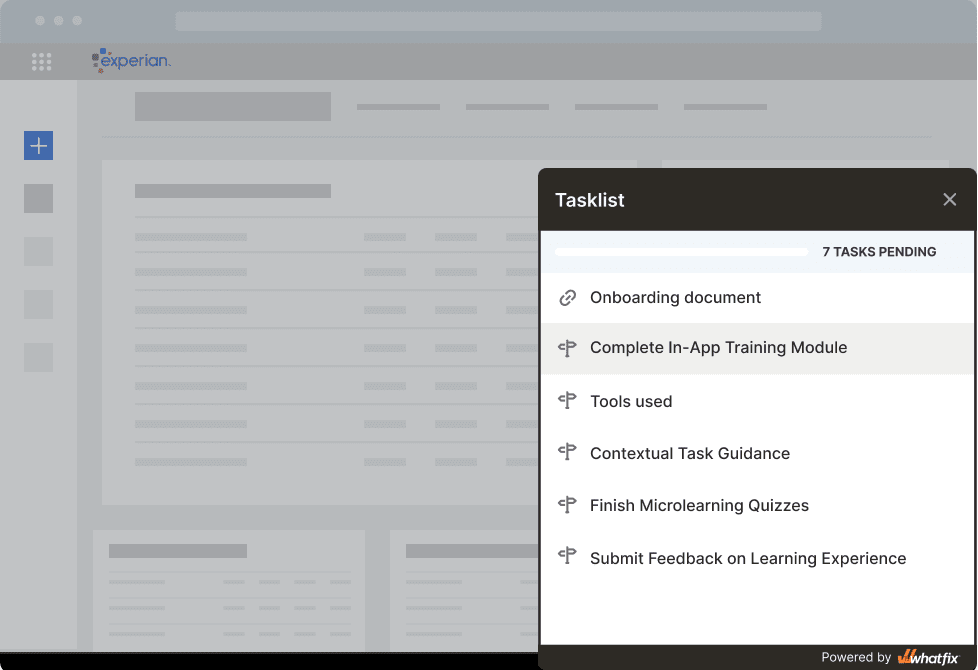
This transformation helped Experian significantly improve adoption across its CRM ecosystem and enabled sellers to leverage new Salesforce capabilities to their full potential, ultimately empowering the organization to achieve key revenue goals tied to its CRM investment.
“It was a great decision to choose Whatfix. With a heavily customized Salesforce instance and multicultural processes to cater to, the flexibility of Whatfix empowers us to get the right training to the right people, at the right time. Its contextual information flags salespeople to potential issues with their opportunities. Make no mistake, Whatfix innovation is helping to drive the next phase of Experian’s growth,” said Glenn.
2. Reducing CRM Friction at Scale: Sophos Supports Ongoing Salesforce Evolution
Sophos faced a significant challenge: its sales team was overwhelmed by frequent Salesforce workflow and process changes, resulting in 12,000+ support tickets related to CRM change-related issues. These constant disruptions made it difficult for reps to stay sales productive and caused significant strain on sales, IT, and enablement teams.
To reduce this friction and drive smoother CRM change management, Sophos implemented Whatfix across its Salesforce environment. Whatfix empowered the organization to embed real-time in-app guidance, Pop-Ups for communicating new CRM feature releases, and role-based Smart Tips to assist sellers through updated workflows. These tools provided sellers with just-in-time, contextual help—reducing reliance on external documentation and repetitive support requests.
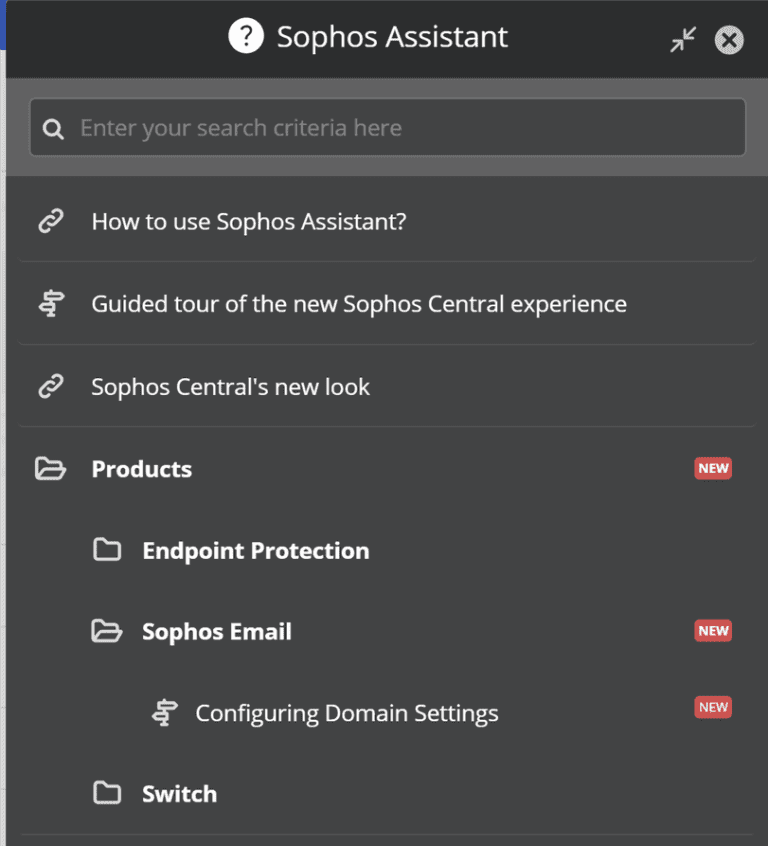
With Whatfix, Sophos eliminated all 12,000 annual CRM-related support tickets, enabling smoother transitions during system updates, driving better feature adoption, and giving time back to its IT and enablement teams.
3. Legacy to Modern CRM: Reed Facilitated Risk-Free Change With Whatfix
Global recruitment leader Reed modernized its sales tech stack by replacing a 15-year-old legacy CRM system, without sacrificing business continuity or sales team performance.
The challenge? Decades-old workflows, manual processes, and disconnected sales tools had deeply ingrained behaviors that were hard to unwind.
Reed leveraged Whatfix to embed step-by-step Flows, Self Help widgets, and interactive training directly into its new CRM environment to ensure a smooth transition. Whatfix enabled the company to digitally transform its CRM onboarding and training program, providing intuitive support without needing additional classroom sessions or external webinars.
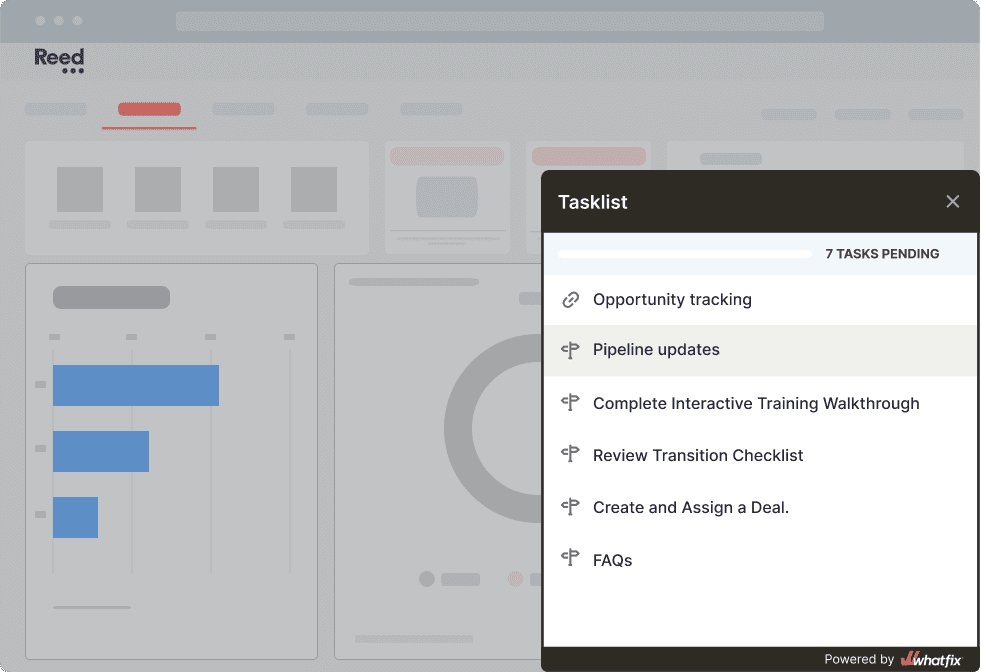
The result was a seamless CRM rollout across the organization, with zero drop in productivity or revenue impact. Reed’s sales teams could stay focused on closing deals while adapting to the new system with minimal disruption.
4. REG Cuts CRM Ramp Time in Half With Embedded Workflow Support Across Multiple Enterprise Applications
Renewable Energy Group (REG) needed to onboard new sales reps onto multiple enterprise applications for its cross-app workflows: Salesforce CRM and JD Edwards ERP. The complexity of toggling between tools and understanding fragmented workflows created long ramp times and inconsistent CRM data entry.
REG partnered with Whatfix to provide real-time Flows, Smart Tips, and embedded task assistance for its users within the flow of work. This approach reduced learning curves and ensured reps could complete CRM tasks confidently and accurately without needing constant IT support or referring to external documentation.
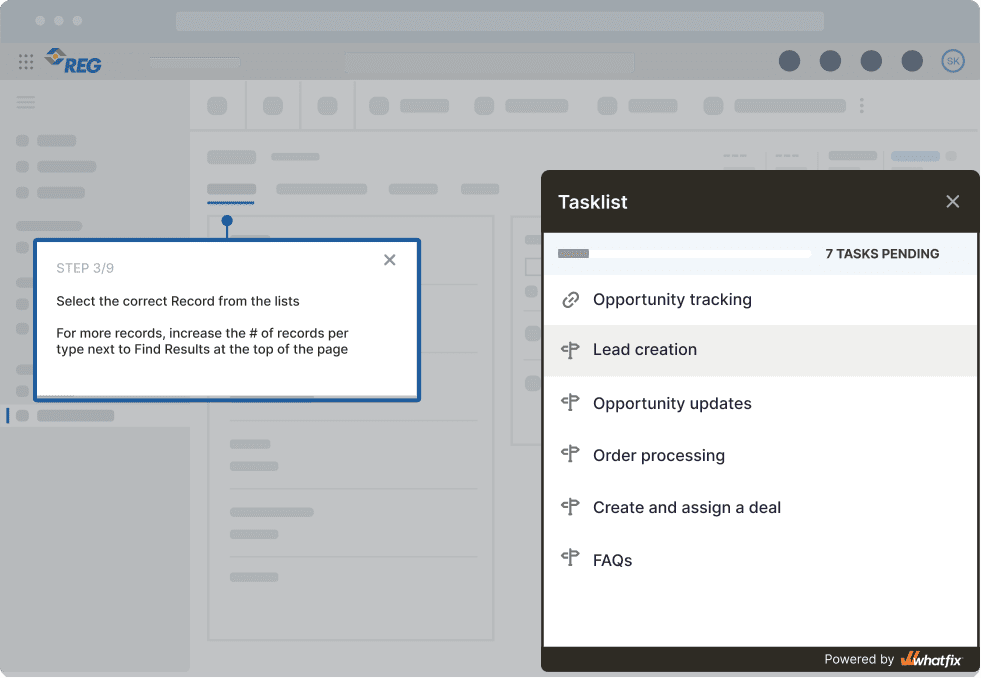
With Whatfix, REG saw a 50% reduction in time-to-proficiency for new sales team members. It helped standardize CRM usage across teams, improved sales data integrity, and ensured a faster path to productivity for every rep.
“Whatfix reimagines our training. The DAP is easy to use – even for non-technical users. It supports in-application guidance across almost any interface and platform. And it’s so easy to update materials, we can at last keep pace with the system changes. Looking back, Whatfix was one of the best decisions we have made,” said Abby Essing, Sr. Manager of Operations Services at REG.
5. Hays Replaced Outdated CRM Training With Scalable, In-App Enablement
Hays relied on manual CRM training programs (including long webinars, static SharePoint knowledge bases, traditional classroom sessions, and internal listserv sales newsletters) to onboard and retrain its global sales team. The result was a fragmented experience that couldn’t keep up with the pace of CRM updates or adequately support reps in the flow of work.
“Our CRM is developing continuously,” said Charlotte Binder, Project Manager Business Solutions at Hays. “We benefit from a lot of new features, but because we have so many employees, we had challenges enabling everyone on the new enhancements for each release. We wrote a newsletter, created a SharePoint site, and held training sessions. You still lose people. Not everyone reads the newsletter. People aren’t interested in getting on a call.”
With Whatfix, Hays overhauled its CRM training model by embedding on-demand support, Flows, and Pop-Ups into the CRM interface. Now, sellers receive proactive alerts about new CRM features, just-in-time process training, and contextual task assistance—all without leaving the platform.
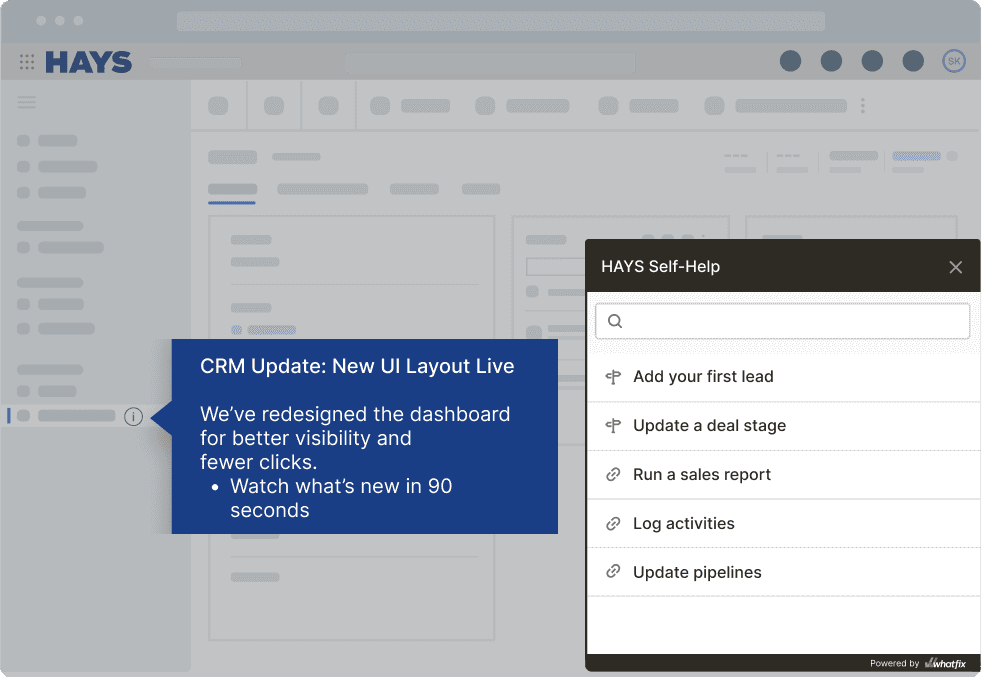
This shift drastically improved CRM engagement and reduced the support load on internal teams. Hays now has a scalable, self-service CRM enablement model that supports continuous change, while keeping sellers productive and focused on revenue-generating activities.
“There isn’t just one feature that has made the most impact,” said Katja Marggraf, CRM Application Owner at Hays. “It’s all of the Whatfix features working together that have changed the way our users learn and work. It enables users to search in-app and find answers to their questions quickly. This combination of features has truly streamlined our workflow.”
How to Achieve Full ROI From CRM Change Projects With Whatfix
CRM change projects don’t automatically lead to business impact. You can migrate systems, re-train your sales team, and launch new features—but if users don’t adopt the CRM fully and consistently, the value never materializes.
Real ROI comes from enabling your teams to use the CRM the right way—every day, at every stage. That means supporting your sales organization not just during go-live, but across the entire lifecycle of your CRM.
Whatfix helps sales, operations, and IT teams drive sustained CRM adoption and maximize ROI by delivering support at the exact moments employees need it. Here’s how Whatfix supports CRM value creation at each stage of your change journey:
User Testing Pre-Launch
Before you roll anything out, your reps need the opportunity to explore the new CRM in a safe, structured way. With Whatfix Mirror, you can build sandbox environments that replicate your CRM setup—so sellers can test workflows, spot friction, and give feedback before those issues affect real deals. This early alignment helps identify workflow gaps and accelerate time-to-readiness.
CRM User Training & Onboarding:
Most CRM onboarding relies on static documentation or one-size-fits-all sessions. Whatfix replaces this with role-based, in-app onboarding that guides each user through their most critical tasks, live in the CRM. Whether it’s logging a new opportunity, updating pipeline stages, or syncing activities to an account, reps get contextual help exactly where and when they need it.
Embedded CRM Support in the Flow of Work
Reps shouldn’t have to leave the CRM or raise a support ticket just to remember how to update a field or trigger a workflow. With embedded self-help widgets, tooltips, and smart nudges, Whatfix keeps your team supported within the platform—minimizing downtime, confusion, and errors.
Support Agile Change Management and New Feature Rollout
Whether you’re rolling out new CRM features like Salesforce’s Agentforce, updating compliance workflows, or restructuring your team, change never stops. With Whatfix, you can instantly launch new in-app guidance and walkthroughs to help users adapt—without re-training or pausing productivity.
Continuous Task and Workflow Optimization
Using Whatfix Analytics, sales ops and enablement leaders can track how reps interact with key CRM workflows in real time. Where are they getting stuck? What steps are being skipped? What actions are slowing things down? These insights help teams fine-tune workflows and launch targeted guidance to eliminate blockers before they snowball into lost deals or inaccurate data.
Long-Term CRM Value Realization
Adoption isn’t a one-and-done metric—it’s a continuous process. Whatfix helps teams monitor CRM usage over time, benchmark performance, and keep reps engaged with adaptive content that evolves alongside your CRM strategy. That long-term focus on usability and behavior change is what turns a successful CRM migration into sustained business impact.
Ready to get started? Explore Whatfix for CRM now or see the power behind the innovative technology by requesting a Whatfix demo led by a digital adoption expert.

